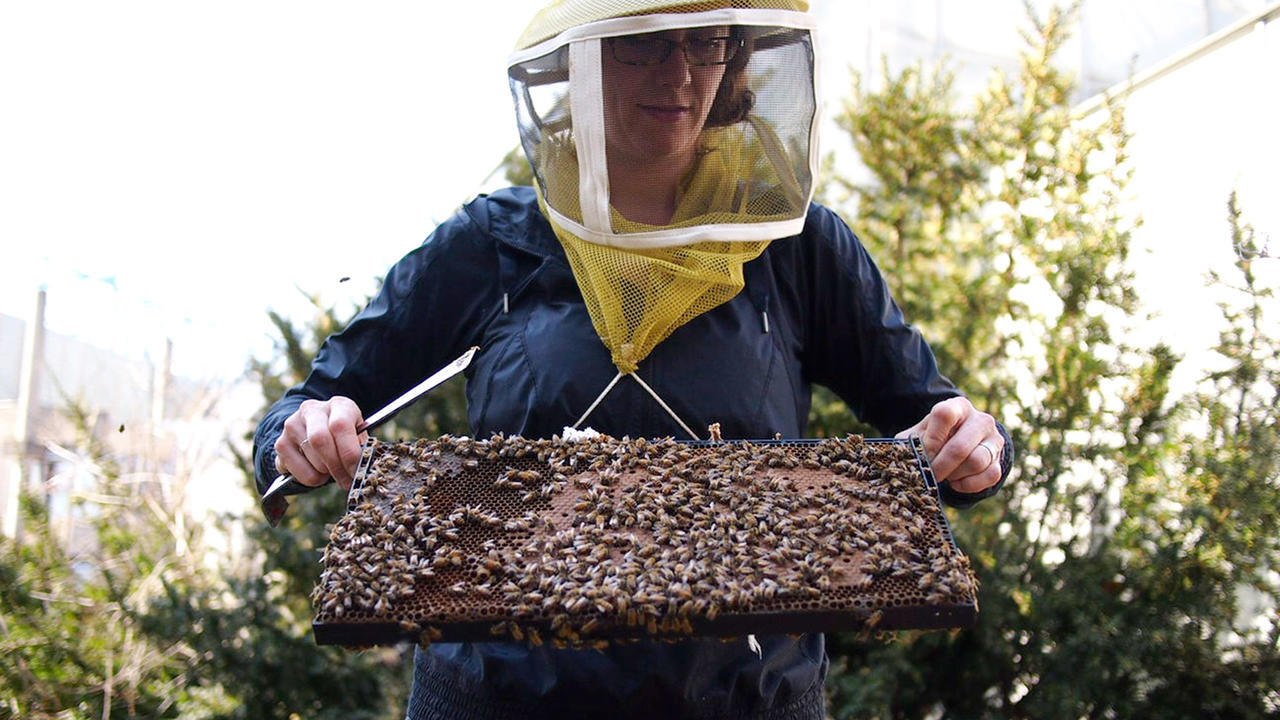
How Bees Tell Murder Hornets to Buzz Off
Heather Mattila has had a busy year. Last December, she published groundbreaking new research detailing how honey bees use tools to spread dung on the entrances of their hives to protect themselves from giant hornets. Now, the associate professor of biological sciences at Wellesley is building on her knowledge of the defense systems of honey bees, this time with a paper in Royal Society Open Science about the alarms honey bees sound to alert the hive when a giant hornet attacks.
Mattila made this latest discovery partially by chance. While in Vietnam studying Asian honey bees, she was observing a giant hornet attack, and she remembers thinking the bees were making a lot of noise. “I kept saying, ‘They are really freaking out,’” she said. Mattila bought microphones to put in the colonies to record the bees, and she was amazed by the sounds they made: “It gave me chills when I heard them. These bees were in so much distress, and something in me recognized that feeling of danger.”
A giant hornet can destroy a honey bee nest in a couple of hours, so these defenses are crucial. Asian honey bees protect themselves in a number of ways, including using dung as a hornet repellent, as Mattila discovered previously. But without some bees sounding the alarm, the other bees would not know to rally their defenses. Mattila and her team’s discovery is integral to understanding these honey bees’ complex methods of survival.
After Mattila and her team recorded 1,300 minutes of audio from the honey bees, they faced the challenge of deciphering these sounds. While Mattila has been studying honey bee behaviors her entire career, sounds were new territory for her. This is where Hannah Kernen ’20 came in. At Wellesley, Kernen researched the sounds of honey bees for three years, starting the summer before her junior year, and she wrote her honors thesis on the topic. While studying bird calls in Costa Rica during her junior year, she realized that the technology she was using to interpret the bird calls would work perfectly for the honey bee audio. She spent the rest of her trip learning to use the software so that she could teach it to the lab team when she returned.
It gave me chills when I heard them. These bees were in so much distress, and something in me recognized that feeling of danger.
Heather Mattila, Associate Professor of Biological Sciences
After mastering the software, Kernen and Mattila still had a lot of work to do. The team had to listen to all the audio and make note of each distinct signal by hand. “By the end of the process, we isolated over 29,000 individual signals, all of which were checked and double-checked by myself, Heather, and several other Wellesley students,” Kernen said. Kernen worked in Mattila’s lab after she graduated to help finish up this analysis. The work was tedious and time-consuming, but it paid off: Kernen is a co-author of the Royal Society report, her first published paper.
While discovering the auditory warnings of honey bees to alert their hive of giant hornets is a huge step in understanding the interactions between these two species, Mattila feels that there is still much more to learn. “We know a lot about European honey bees, but there’s always more to find out about the interactions between Asian honey bees and giant hornets,” she said, “We have a thousand unanswered questions.” So, after two incredible discoveries about Asian honey bees and giant hornets, Mattila plans to continue her research into these two species.
Mattila’s research is also relevant to European honey bees here in the U.S. Murder hornets, a closely related species of the giant hornet, have been introduced in the Pacific Northwest, and the European honey bees do not have the defenses or warning mechanisms of the Asian honey bees Mattila researches. As the European honey bees face the challenge of defending themselves against this new predator, Mattila’s findings will be significant to the study of honey bees in the U.S. and across the world.
Both Mattila and Kernen have exciting plans for the future: Kernen is pursuing a master’s degree in entomology, and Mattila will continue to study Asian honey bees. Yet both of them look back with pride on their time researching the honey bees’ warning sounds. “This has been a huge learning experience for me,” Kernen said, “It definitely taught me a lot about how to tackle problems that at first seem insurmountable.”



